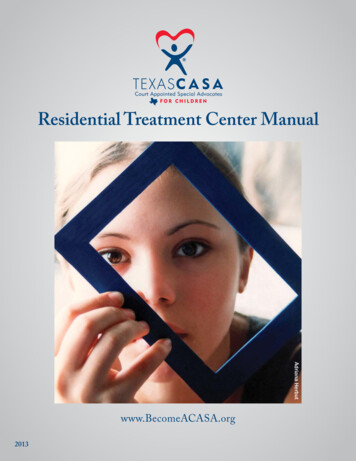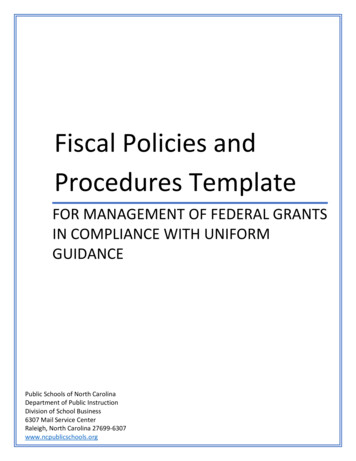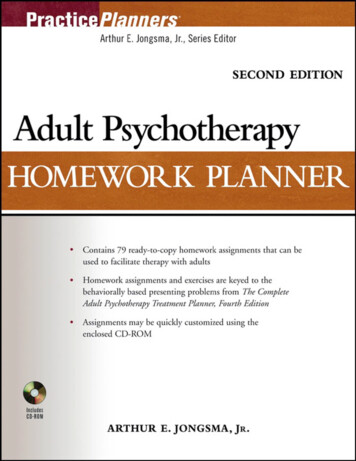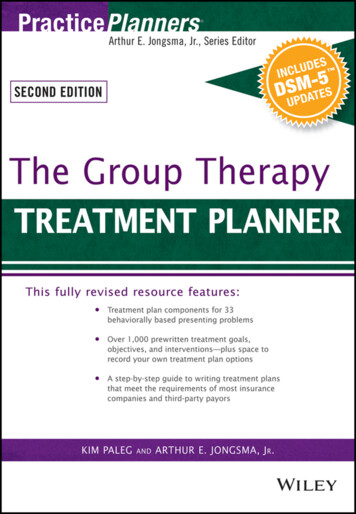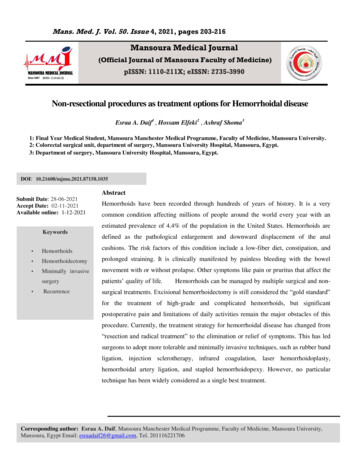
Transcription
Mans. Med. J. Vol. 50. Issue 4, 2021, pages 203-216Mansoura Medical Journal(Official Journal of Mansoura Faculty of Medicine)pISSN: 1110-211X; eISSN: 2735-3990Non-resectional procedures as treatment options for Hemorrhoidal diseaseEsraa A. Daif1 , Hossam Elfeki2 , Ashraf Shoma31: Final Year Medical Student, Mansoura Manchester Medical Programme, Faculty of Medicine, Mansoura University.2: Colorectal surgical unit, department of surgery, Mansoura University Hospital, Mansoura, Egypt.3: Department of surgery, Mansoura University Hospital, Mansoura, Egypt.DOI: 10.21608/mjmu.2021.87158.1035AbstractSubmit Date: 28-06-2021Accept Date: 02-11-2021Available online: 1-12-2021Hemorrhoids have been recorded through hundreds of years of history. It is a verycommon condition affecting millions of people around the world every year with anestimated prevalence of 4.4% of the population in the United States. Hemorrhoids areKeywordsdefined as the pathological enlargement and downward displacement of the anal Hemorrhoidscushions. The risk factors of this condition include a low-fiber diet, constipation, and Hemorrhoidectomyprolonged straining. It is clinically manifested by painless bleeding with the bowel Minimally invasivemovement with or without prolapse. Other symptoms like pain or pruritus that affect thesurgerypatients’ quality of life.Recurrencesurgical treatments. Excisional hemorrhoidectomy is still considered the “gold standard” Hemorrhoids can be managed by multiple surgical and non-for the treatment of high-grade and complicated hemorrhoids, but significantpostoperative pain and limitations of daily activities remain the major obstacles of thisprocedure. Currently, the treatment strategy for hemorrhoidal disease has changed from“resection and radical treatment” to the elimination or relief of symptoms. This has ledsurgeons to adopt more tolerable and minimally invasive techniques, such as rubber bandligation, injection sclerotherapy, infrared coagulation, laser hemorrhoidoplasty,hemorrhoidal artery ligation, and stapled hemorrhoidopexy. However, no particulartechnique has been widely considered as a single best treatment.Corresponding author: Esraa A. Daif, Mansoura Manchester Medical Programme, Faculty of Medicine, Mansoura University,Mansoura, Egypt Email: esraadaif26@gmail.com, Tel. 201116221706
204Daif et al.,Surgical intervention is typically indicated inINTRODUCTIONThe term "haemorrhoid" is a Greek word thatlow-grade hemorrhoids that failed to respond tomeans flowing blood, and it was most likelynon-surgicalHippocrates (460 BC) who used this term for thesymptomatic hemorrhoids. Also, surgery may befirst time to describe the blood flow from theindicated if the patient has other anorectalanal veins (1). Hemorrhoids occur in the anusdisorders requiring intervention. The goldand lower rectum due to dilatation and swellingstandard operation for grade Ⅲ-Ⅳ hemorrhoidsof veins, and by definition, they are symptomaticis excisional hemorrhoidectomy. Excisionalenlargement and downward displacement ofhemorrhoidectomy can be further subdividednormalManyinto closed (Ferguson) hemorrhoidectomy andprecipitating factors have been attributed to theopen (Milligan Morgan) hemorrhoidectomy.occurrence of hemorrhoids, including a low-Both had similar efficacy and safety (4),fiber diet, chronic constipation, and prolongednevertheless, the Ferguson approach might bestraining. The patient may have manifestations,superior to the Milligan-Morgan approach inforbowelterms of long-term patient satisfaction andmovement, pain or a burning sensation, prolapsecontinence and both techniques may lead toof tissue from the anus, and pruritus around thesignificant postoperative heanus (2).treatmentandinhigh-gradeIn order to reduce or eliminate post-Hemorrhoidal disease accounts for about 3.3operative pain, more recent minimally invasivemillion outpatient care visits in the United Statesmethodsand is ranked as the fourth leading outpatientinjectiongastrointestinal diagnosis. The incidence ofhemorrhoidalhemorrhoids in the US is about 10 million ahemorrhoidopexy have been adopted into theyear, equivalent to 4.4% of the population. Thetreatment of hemorrhoids. Further, perioperativepeak incidence ranges between age 45 to 65care for hemorrhoids has improved dramaticallyyears in both genders. Caucasians are more(6).likely to be affected than African ler-guidedandstapledThis essay aims to review the optionshighavailable for the management of hemorrhoidssocioeconomic status. Despite its prevalence andconcentrating on the effect of minimallylow morbidity, hemorrhoid disease greatlyinvasive techniques to provide a framework toaffects the quality of life and can be managedselect the best procedure for different patients inwith a wide variety of surgical and nonsurgicalorder to minimize complications and to obtaintreatments (3).the cure for this problem.
205Non-resectional treatment for hemorrhoidal diseaseManagement of Hemorrhoids2-In most cases, hemorrhoid disease is self-Dietary and lifestyle modifications are thelimited. The treatment of symptomatic cases thatcornerstonecome to the outpatient clinic or emergencyhemorrhoid disease. Increasing fluid intake,departmentconservativedecreasing consumption of fat, regular physicalinterventions and office procedures to surgery.activity should be considered. Low fat, high-Asleast-invasivefiber diet helps to avoid constipation andtechniques should be considered first, except instraining. Consumption of 7-20 gm of fibers percases of complications such as acute thrombosis.day can reduce the risk of bleeding by 50%,The therapeutic method of choice is decidedproven by a meta-analysis of seven randomizedbased on the severity of the condition, thetrials comparing fiber to non-fiber controls. But,patient’s desire, the comorbidities, and theit does not improve other symptoms likeexpertise of physicians(3).prolapse and pain (8).avariesgeneralfromconcept, theLifestyle and dietary modificationinconservativetreatmentofConservative management:Conservative treatment is considered the basic3-treatment of hemorrhoids. It is applicable in allThere are two roles of medications in treatmentgrades of hemorrhoids and associated with aof hemorrhoids, either a protective treatmentcertain degree of improvement, irrespective ofagainst prolapse for the early stages in which thetheir severity. This treatment consists of threeprolapse is not evident or as an initial control forcomponents:bleeding until the definitive management isHotsitzbath,lifestyleMedicationsmodification, and medications (3).done. The function of these medications is the1-improvement of the hemodynamics in theHot Sitz BathThese hot baths help to eliminate the pain byhemorrhoidal plexus through reinforcing thelowering anal pressure, keep the anus clean,venous and capillary walls, anti-inflammatoryrelaxbloodagents, and laxatives. These drugs are availablecirculation that relieves congestion and edema.in many forms including tablets, suppository,So it is an important item of conservativeointment, and injections (9).A large meta-treatment and postoperative care and helps toanalysis studied the effect of phlebotonics onprevent other benign anal diseases like analhemorrhoids and revealed that phlebotonics hadfissures. The patient is advised to sit in warma great effect on most of the symptoms includingwater of 40-44 C for 3 min. In the past, 20 minbleeding, pruritus, and discharge. Flavonoids areof a sitz bath was advised, but recently, a shorterthe most common oral phlebotonics used in theduration is recommended because of thetreatment of hemorrhoids. Flavonoids couldpossible congestion and prolapse (7).improve vascular tone and lymphatic drainage,musclesandimproveanal
206Daif et al.,reduce capillary permeability, and have anti-is safe to ligate more than one at the same timeinflammatory action dures) (OBP)Rubber band ligation works well in patients withAccording to The American Society of Colongrade II and early grade III internal hemorrhoidsand Rectal Surgeons (ASCRS) Guidelines forand if there is any contraindication to surgicalManagement of Hemorrhoids (2018), there isintervention(14). About 8 out of 10 patients canstrong evidence that early stages including gradebe managed successfully with RBL. The averageI, II, and even selected cases with grade IIIimprovement ranges from 73% to 84% (15). Thewhichconservativeproblem with RBL is that it is not applicable formanagement can be successfully managed withlate grade III and grade IV internal hemorrhoidsoffice-based procedures (OBP). Various OBPor for external hemorrhoids. It is cannot be doneare available including rubber band ligation,in too large or too small internal hemorrhoids.injection sclerotherapy, infrared coagulation,The large hemorrhoids cannot be controlled bycryotherapy, and radiofrequency ablation (11).the ligation device because their maximum1-Rubber band ligation (RBL)caliber is just 1 cm. While the rubber bands areRBL is the most common OBP because it iseasily slipped out in the small hemorrhoids. Thisrelatively effective, simple, inexpensive, and hasprocedure is contraindicated in patients witha low risk of complications (12). This procedureanalis done using an ansoscope while the patient isproblem.(14)lying in the left lateral or Jackknife position.The common complications of this technique areDiverse devices are available, yet the two mostbleedingcommon devices used for ligation are McGivneypostoperative pain is in the range of 8-80% inforceps ligator and the suction ligator. Smallvarious randomized clinical trials. Post-operativerubber band rings are applied firmly around thebleeding is reported in up to 50% of cases in abase of hemorrhoids, at least half a centimeterRCT done by Ramzisham, however, lower ratesabove the dentate line to be away from theare reported by other RCTs(16). The recurrencesomatically innervated part of the anal canal(3).rates of bleeding and prolapse at follow-up areThe rubber bands block the blood flow resulting10%-18% and 2.2% of patients respectivelyin ischemic necrosis. The necrotic hemorrhoids(15). Sepsis has also been reported. Urinaryfall off within 7-10 days from the procedure.retention is reported in very rare cases (3). TheExperts recommend starting by ligating just apatient should stop the anticoagulants andsingle column in the first time to check theantiplatelets if possible one week before and twoarerefractorytopatient’s tolerance to this procedure. However, of
207Non-resectional treatment for hemorrhoidal diseaseweeks after the procedure because those patientshemorrhoids with prolapse especially withhave a higher risk of perioperative bleeding (17).ALTA but more studies are needed to state its2- Injection sclerotherapy (IS)efficacyInjection sclerotherapy is another alternative forcontraindicated if there are any associated analthe treatment of hemorrhoids. This technique isconditions such as fistula, tumors, or analdone by injecting the sclerosant agent throughfissures. It is also contraindicated in externalthe anoscope in the hemorrhoidal tissuehemorrhoids and thrombosed hemorrhoids (21).resulting in necrosis and later on scaring andfixationofmucosasclerotherapyisIS has a relatively low incidence of pain afterthe procedure in grade I ranging from 36% tosubmucosa. Over time, several sclerosant agents49% reported by different studies. The incidencehave been used including 5% phenol in almondof post-procedural bleeding is very rare (15).oil, urea hydrochloride, and quinine. Recently,Anal fistulas and perforation may occur becausethe new Aluminum sulfate, as well as tannicof misplaced injections, but this is very rareacid (ALTA), is used routinely in Japan as a(3).The sclerosant agent should be injected inminimally invasive alternative for the treatmentthe submucosa at the base of hemorrhoidalofstrongtissue, not in the hemorrhoids themselves toinflammatory reaction and fibrosis, proteinavoid the hazards of misplaced injections. Thecoagulation, and contraction of the bloodmisplaced injection causes immediate precordialvessels, leading to subsequent sclerosis andand upper abdominal pain as well as mucosalfixation of hemorrhoidal tissues(19).ulcerationsALTA can treat both bleeding and prolapsedretroperitoneal abscesses (22). Patients withinternal hemorrhoids unlike 5% phenol almondvalvular heart diseases or any immunodeficiencyoil which is successful only for bleeding internalcondition should take antibiotic prophylaxishemorrhoids. Yuksel reported a subjectivebecause there is a risk of bacteremia after theexcellent improvement in 51% of cases withprocedure (23).grade I and grade II hemorrhoids, while MoserComparedreported a rate of 80% subjective improvementsclerotherapyin grade I hemorrhoidsonlyminimally invasive and associated with mildprospective study that is adequately linked topost-procedure pain, low incidence of bleeding,grade III and grade IV demonstrated only 70%and more rapid return to daily activities (18).ofmoderate/excellentFurthermore, no need to stop antithromboticimprovement(15).So this procedure appearstreatment before or after the procedure and it caneffective in grade I and II internal hemorrhoidsbe repeated in case of recurrence. dsto(20).IScauses(19). Thewith bleeding as well as grade III and ithlikeinjectionsurgeryis
208Daif et al.,3- Infrared Coagulation (IRC)and 22% in grade II and grade III respectively.Infrared coagulator emits infrared radiationOn the other hand, two other RCTs have shownresulting in tissue coagulation and watermoderate improvement in 81% and 93% forevaporation in the cell resulting in hemorrhoidsgrade I and grade II hemorrhoids. So, IRC canshrinkage. The procedure is done through thebe considered an alternative for the managementanoscope while the patient is placed on the leftof I and II hemorrhoids degree(15).side and the probe is inserted and applied to thebase of the hemorrhoid for about 1.0-1.5 s, twoThe incidence of post-procedural pain isor three times for each hemorrhoidal mass. Thedifferent in various RCT ranging from 16% upprolapsed hemorrhoids may need five or sixto 100% of cases (26). Dimitroulopoulos in histimes per each one. After the procedure, theRCT reported post-operative bleeding in 44% ofnecrotic tissues appear as white areas and healspatients; in Gupta’s RCT the rate of bleedingwith fibrosis (23).was just 15%. Two RCTs showed a 13% ofThere are few patients who experiencerecurrence rate for bleeding in grades I and IIwarmth in the rectal and anal region whenafter 3 months on follow-up(27, 28).infrared radiation is applied and usually itA meta-analysis of 18 trials comparing betweendecreases within 60 minutes after the procedure.the different office procedures showed higherVery few patients may have less discomfort,success rates with RBL than sclerotherapy inlasting for about 7 to 10 days after IRC. Theregrades I and III, without variance in themay be post-procedural bleeding or spotting.incidence of complications. Jutabha a successThe patient can return to the usual dailyrate of 92% for rubber band ligation and 62% foractivities but should avoid any hard work forinfrared coagulation (29). The studies alsotwo or three days (2). IRC does not have the riskconducted that the patients managed with IS andof misplaced injection and less technique-IRC required additional treatment later on moredependent, unlike sclerotherapy. Despite safetythan those treated with RBL. Eventually,and rapidness, the IRC technique is difficult towhereas the rate of postoperative pain wasbe applicable for advanced and prolapsinghigher with RBL, the recurrence rate was lesshemorrhoids (25).than IS and IRC (3).The rates of improvement in different grades4-Cryotherapyof hemorrhoid are evaluated by one randomizedCryotherapy ablates the hemorrhoids using aclinical trial that showed variable degrees offreezing cryoprobe. After using local anesthesiaimprovement according to the grades; in grade Ito numb the region, the surgeon will apply eitherthere was 78% improvement, while only 55%nitrous oxide or liquid nitrogen using the
209Non-resectional treatment for hemorrhoidal diseasecryoprobe resulting in solidification of internalcommon and agonizing complication is pain. Itor external hemorrhoids. The hemorrhoidsmay also cause bleeding (0.03%-0.6%), septicshrink and fall off within 2-3 weeks. Thiscomplicationsprocedure is associated with more pain and thereretention (2%-36%), anal stenosis (0%-6%),is a higher risk of complications such assphincter damage resulting in fecal incontinencebleeding and contamination (30). Cryotherapy(2%-12%) and long recovery time. Nowadays,was commonly done in 1970-1990, but now it isnew minimally invasive procedures are adoptedrarely used because of the long therapeuticto avoid these complications such as laserperiod, profuse offensive serous discharge, andhemorrhoidoplasty, hemorrhoidal artery ligation,secondary bleeding (31).and stapled hemorrhoidopexy (2).5-Radiofrequency ablation (RFA)1-This is another option for treatment of low-gradeLaser therapy is a technique used for 5%-5.5%),acuteurinaryLaser hemorrhoidoplasty (LHP)ofadvancedhemorrhoids.Thisablation is the use of high-frequency radioprocedure is done under local, spinal, or generalwaveslowanesthesia. The laser power is directed to thetemperature using radiofrequency microfibercenter of the hemorrhoidal mass. LHP causesterminals.adirect shrinkage of hemorrhoids by about 30%toand progressive shrinkage till the final outcomehemorrhoids resulting in coagulative necrosisis obvious after 45 days (2). The laser energyand evaporation of water from cells (32). Thiswhich is applied submucosally destroys theprocedure reduces the vascular content ofhemorrhoidal mass from inside while preservinghemorrhoidal tissues leading to fibrosis andthe covering mucosa and the structure of thesubsequentthesphincter (34). Also, there is fibrosis andsubmucosa. It may cause perianal thrombosis,formation of new connective tissue to ensureinfection, and acute urinary retention. As afixation of hemorrhoids to the underlyingrelatively painless process, RFA shows a highertissues. This method occludes the arteries in analincidence of recurrent bleeding in addition tocushions, reduces the size of the hemorrhoidalprolapse (33).mass, and maximizes the preservation of theMinimally invasive operative procedurenormalAlthough there is a high risk of post-operativerecurrence of prolapse (2).complications, surgical hemorrhoidectomies areLHP is a hemostatic technique, bactericidal,still considered the treatment of choice forheals rapidly, does not affect the adjacentadvanced hemorrhoidal disease. The moststructures and the incidence of rrhoidstoanatomicalstructuretoprevent
210Daif et al.,complication is low. The risk of bleeding andprolapse. This is why modification of thisstenosistomethod to address the issue of prolapsed mucosaconventional open hemorrhoidectomy, LHP isis a very promising option to use it in theassociated with significantly lesser postoperativeadvanced grades of hemorrhoidal disease.pain during the first month. Moreover, laserPlication, also known as recto-anal repairtherapythan(RAR), mucopexy, or hemorrhoidopexy is theconventional hemorrhoidectomy (15.94 Vs.most recent modification of DG-HAL. After26.76 minutes) which is satisfactory for patientsremoving the doppler probe from the anal canal,with grade III and IV hemorrhoids. However,plication sutures are applied along the length ofthe major drawback of this technology is that itprolapsed hemorrhoids, then these sutures areis relatively expensive (36).tightened to pull up the prolapsed ationcushion. (39)2-Doppler-guidedhemorrhoidalarteryThe merits of this technique are non-excision,less pain, and rapid recovery. A systematicligation (DG-HAL)Also known as Transanal hemorrhoidalreview of 28 trials, including 2904 patients withdearterializationbyall grades of hemorrhoids from I to IV,Morinaga in 1995. The aim of this technique isconducted a recurrence rate ranging from 3.0%symptomatic treatment without excision ofto 60.0% (average rate of 17.5%). The highesthemorrhoidal plexus and overlying mucosa (37).recurrence rate was with grade IV hemorrhoids.The standard DG-HAL is done under local orHowever, the recurrence is not considered anspinal anesthesia using a specialized anoscope.issueA Doppler probe is inserted to identify the mainrelatively safe and can be repeated if the patientfeeding arteries of the anal canal and ligate themhas a good tolerance (38). About 6.4% ofwith absorbable sutures. This procedure reducespatients required re-intervention. The overallthe blood flow of the hemorrhoidal plexusincidence of postoperative complications wasleading to shrinkage of the anal cushions andlow, with a bleeding rate of 5.0% of patients.subsequent symptomatic improvement. BecausePostoperative pain was reported in 0% to 38% ofofcases. The duration of operation ranged from 19itssimplicity(THD) dureiscomplications, it is now considered an optimalto 35 minutes (40).option for treatment of grade II and IIIrequired to study the long-term benefits (39).hemorrhoids in Austria and Italy (38).But standard hemorrhoidal artery ligation doesnot solve the problem of mucosal redundancy orLonger follow-up is
211Non-resectional treatment for hemorrhoidal diseaseOne RCT comparing between recurrence ratesdentate line. In the end, the staple line should bewith RBL and HAL for treatment of grade I andinspected for any bleeding as it may needIII hemorrhoids after one year from theadditional ligation of sutures (3).procedure reported a rate of 49% with RBL and30% with HAL. The group which is treatedA systematic review including 27 studieswith RBL (32%) required additional therapyshowed that SH had lesser pain, shorter durationmore than the group treated with HAL (14%).of operation, and more rapid recovery thanAlthough HAL was associated with more painconventional hemorrhoidectomy, however, theafter the procedure, the symptom scores,rates of recurrence of prolapse and need for re-incidence of complications and 5-level EQ-5Dintervention were significantly higher (42). Aversion (an instrument used to assess the qualitymoreof life) were similar (41).demonstrated that there is no difference in therecentmulticenterrandomizedtrialoutcome between SH and conventional surgery3-after 6 weeks from the procedure (43).Stapled hemorrhoidopexy (SH)Conventional stapled hemorrhoidopexy(CSH),or procedure for prolapse and hemorrhoidsConventional SH is a relatively expensive(PPH), is an alternative to conventionalprocedure and does not have any noticeablehemorrhoidectomy. CSH is done using a circularadvantages over excisional surgery. Moreover, itstaplerofcan cause serious complications such ashemorrhoidal cushions “donut or ring shape”bleeding from the staple line, anal stenosis, andresulting in interruption of the blood flow ofperforation, fecal incontinence, recto-vaginalhemorrhoidal plexus, then makes mucosa tofistula, as well as severe chronic anal pain. Thismucosa anastomosis by circumferential staplewhy this procedure is preferably restricted andline.donethatexcisesacircularpieceIt is effective only in the treatment ofwithcircumferentiallyprolapsinginternal hemorrhoids (11).hemorrhoids by a well-trained surgeon (44).Before inserting the stapler in the anal canal, theThe complications of conventional SH areposterior vaginal wall should be examined. Themostly due to circumferential stapling and overmost important step in the technique is to applystapling in the lower part of the anal canal whichthe sutures in the submucosa at a distance of 4is somatically innervated. A more recentcm from the dentate line to avoid sphinctertechnique,muscle injury. SH is associated with less pain inhemorrhoidopexy (PSH), has been designed tocomparison to conventional hemorrhoidectomyovercome the restrictions of CSH. PHS partiallybecause the staple line is placed above theresects the rectal mucosa over the hemorrhoidscalledpartialstapled
212Daif et al.,and preserves the mucosal bridges in betweenincidence of postoperative pain, stenosis, andmucosectomies. This procedure uses speciallyfecal incontinence. These results prove that PSHdesigned anoscopes, including single-window,is an effective minimally invasive technique thatbi-window,and tri-window anoscopes accordingcan be used for treatment grade III-IVto the condition (45).hemorrhoids (45).Theresultsofthisprocedureareverysatisfactory in the treatment of prolapsingA summary of management options of internalisolatedofhemorrhoids is presented in table (1)and acircumferential hemorrhoids using tri-windowsummary of the available evidence for the non-anoscope as well. Partial resection of mucosaresectional procedures is presented in table (2).hemorrhoidsandtreatmentreduced the number of staples and subsequentlyreduces the inflammation, thus decreasing theTable (1):-Internal hemorrhoids management based on the grade. (14, 36, 45)TreatmentGrade IGrade IIGrade IV⃰⃰⃰⃰selectedBarron lectedInfrared treatment⃰⃰Radiofrequency ablation⃰⃰⃰⃰⃰⃰⃰⃰Lifestyle and dietary modification.⃰Grade IIIMedications⃰Office based procedureSurgical proceduresLaser hemorrhoidoplastyDGHAL PlicationCSHPSH⃰selected⃰DGHAL: Doppler-guided hemorrhoidal artery ligation, CSH: Conventional stapled hemorrhoidopexy, PSH: Partialstapled hemorrhoidopexy, *: Applicable-
213Non-resectional treatment for hemorrhoidal diseaseTable (2):- Summary of the evidence available for the non--resectional atientsOutcome-Resolution ofsymptomsLaserhemorrhoidoplastyLongchamp etal. (46)2021Nonexcisionallasertherapies (LHand HeLP).70 - 100% afterLH and 83.6 90% after HeLP.0 - 1.9%after LHand 5.5- 16.7%after HeLP.0 - 64% after LHand 0 - 23.3%after HeLP.0 - 11.3% afterLH and 5 -9.4%after HeLP.Pain (0 - 38%),bleeding (5%),re-intervention(6.4%)3 - 60%19 – 35 minutes2.9 idal arteryligation-Postoperativecomplications:Pucher et al. (47)2013Emile et al. erilizationGiordano et al.(49 )Stapledhemorrhoidopexy2009Emile et al. (48)2018THDSH1996274-Recurrence-Operative Time-Postoperative painscore-Complications-Recurrence-Postoperative pain-Recurrence-Operative time18.5%9.0% forprolapse5 -50 minutes3.3 1.6-Postoperative 3%6.9%LH: Laser hemorrhoidoplasty, HeLP:Hemorrhoidal laser procedure, DG-HAL: Doppler-guided hemorrhoidalartery ligation, THD:Transanalhemorrhoidaldearterilization, SH: stapled hemorrhoidopexy.3. Sun Z, Migaly J. Review of hemorrhoidReferences1. Al-Tamimi AS. Classical Milligan Morgandisease:presentationHemorrhoidectomy versus its ulaandMucosalEctropion. International Journal of Medicalincolonandandmanagement.rectalsurgery.4. Ho Y, Buettner P. Open compared with closedResearch & Health Sciences. 2018 Janhaemorrhoidectomy:1;7(1):144-51.randomized controlled trials. Techniques in2. Gupta S, Singh TG, Baishnab S, Garg N,KaurK,SatijaS.RECENTMANAGEMENT OF HEMORRHOIDS: antSURGICALArchives.meta-analysisofcoloproctology. 2007;11(2):135.5. Yeo D, Tan K-Y. Hemorrhoidectomy-makingsense of the surgical options. World JournalofGastroenterology:2014;20(45):16976.WJG.
214Daif et al.,6. Lohsiriwat V. Update on common morrhoids. InHemorrhoids 2014 (pp. 4763). Springer, Berlin, Heidelberg.HK.Nonsurgicaltreatmentof15. Cocorullo G, Tutino R, Falco N, Licari L,hemorrhoids. Hemorrhoids: Springer; 2014.Orlando G, Fontana T, et al. The non-p. 47-63.surgical8. Alonso-Coello P, Mills E, Heels-Ansdell D,López-Yarto M, Zhou Q, Johanson JF, etal. Fiber for the treatment of hemorrhoidsmanagementforhemorrhoidaldisease. A systematic review. Il Giornale dichirurgia. 2017;38(1):5.16. Cazemier M, Felt-Bersma R, Cuesta M,complications: a systematic review and meta-Mulderanalysis.hemorrhoids: flexible gastroscope or rigidAmericanJournalofGastroenterology. 2006;101(1):181-8.proctoscope?9. Committee CP. American icbandWorldligationJournalofofGastroenterology: WJG. 2007;13(4):585.17. Iyer V, Shrier I, Gordon P. Long-termoutcomeofrubberbandligationfordiagnosis and treatment of hemorrhoids.symptomatic primary and recurrent internalGastroenterology. 2004;126(5):1461-2.hemorrhoids. Diseases of the colon & rectum.10. Lohsiriwat V. Treatment of hemorrhoids: Acoloproctologist’s view. World Journal ofGastroenterology: WJG. 2015;21(31):9245.2004;47(9):1364-70.18. Miyamoto H, Hada T, Ishiyama G, Ono Y,Watanabe H. Aluminum potassium sulfate11. Davis BR, Lee-Kong SA, Migaly J, Feingoldand tannic acid sclerotherapy for GoligherDL, Steele SR. The American Society ofgrades II and III hemorrhoids: results from aColon and Rectal Surgeons clinical practicemulticenterguidelineshepatology. 2016;8(20):844.forthemanagementofhemorrhoids. Diseases of the Colon &Rectum. 2018;61(3):284-92.study.Worldjournalof19. Yuksel BC, Armagan H, Berkem H, YildizY, Ozel H, Hen
Corresponding author: Esraa A. Daif, Mansoura Manchester Medical Programme, Faculty of Medicine, Mansoura University, Mansoura, Egypt Email: esraadaif26@gmail.com, Tel. 201116221706 DOI: 10.21608/mjmu.2021.87158.1035. Daif 204et al., INTRODUCTION The term "haemorrhoid" is a Greek word that means flowing blood, and it was most likely .





